Analyzing Financial Resources in the Hospitality Sector: A Report
VerifiedAdded on 2023/06/16
|15
|3133
|92
Report
AI Summary
This report provides an in-depth analysis of managing financial resources within the hospitality industry. It begins by explaining Generally Accepted Accounting Principles (GAAP) and identifying various users of financial statements, along with their information needs. The report discusses the relevance of income statements, balance sheets, and cash flow statements to loan and trade creditors. Furthermore, it explores the components that supplement financial statements in an annual report and delves into key financial reporting concepts. A significant portion of the report is dedicated to interpreting financial statements using financial ratios, comparing performance across two years, and evaluating key metrics such as net profit margin, return on assets (ROA), return on equity (ROE), current ratio, and quick ratio, offering insights into the financial health and operational efficiency of Smart Resort Ltd. The analysis concludes with recommendations for improving financial performance and stakeholder value.
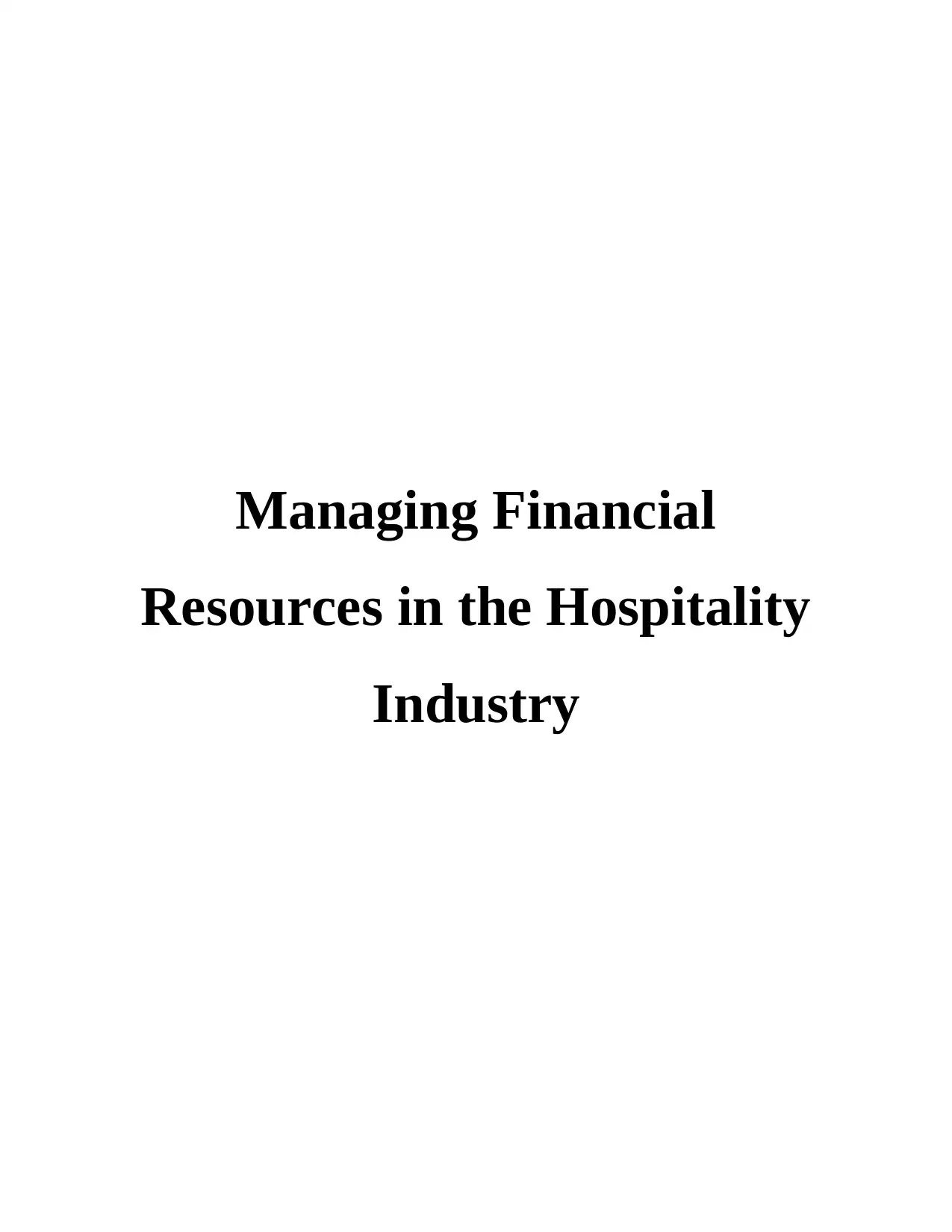
Managing Financial
Resources in the Hospitality
Industry
Resources in the Hospitality
Industry
Paraphrase This Document
Need a fresh take? Get an instant paraphrase of this document with our AI Paraphraser
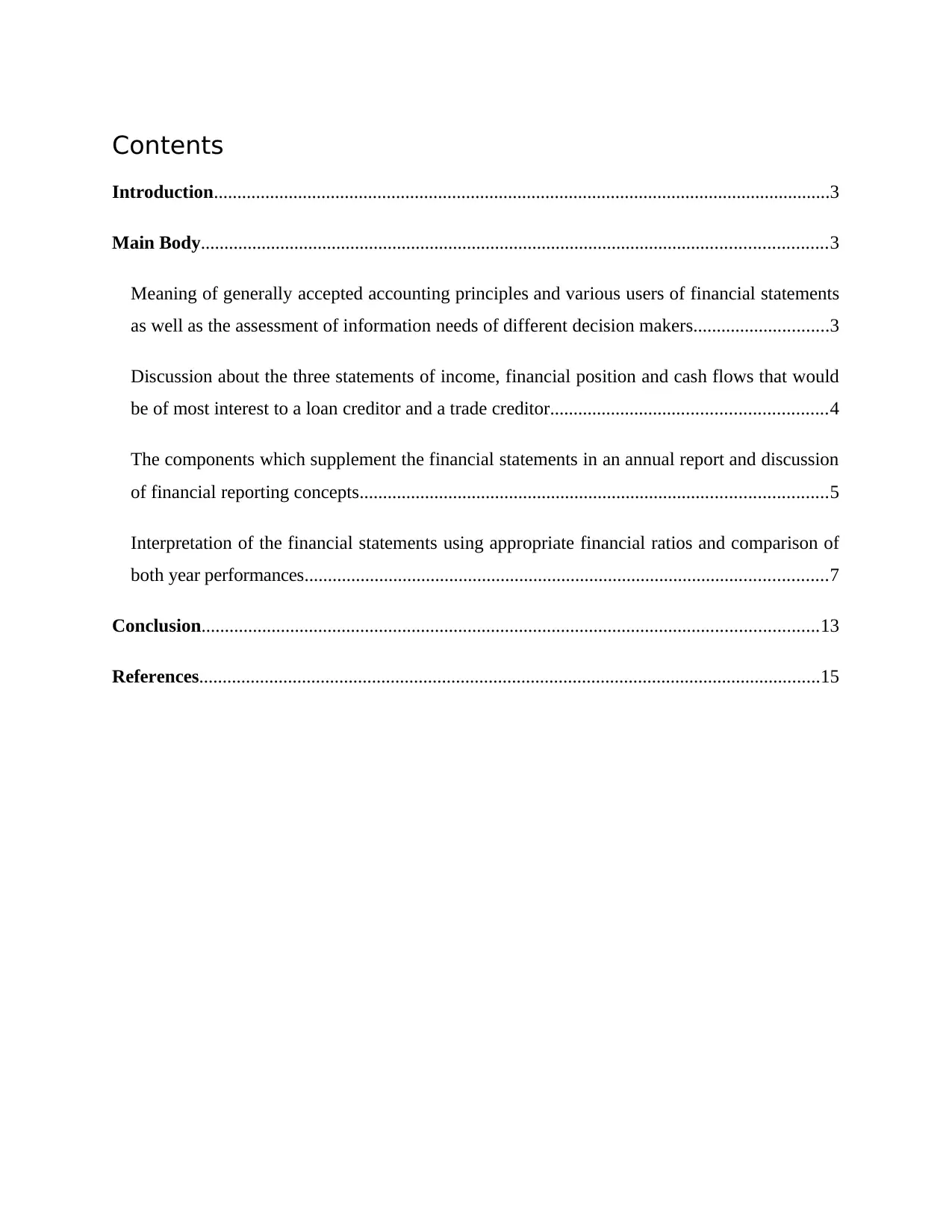
Contents
Introduction....................................................................................................................................3
Main Body......................................................................................................................................3
Meaning of generally accepted accounting principles and various users of financial statements
as well as the assessment of information needs of different decision makers.............................3
Discussion about the three statements of income, financial position and cash flows that would
be of most interest to a loan creditor and a trade creditor...........................................................4
The components which supplement the financial statements in an annual report and discussion
of financial reporting concepts....................................................................................................5
Interpretation of the financial statements using appropriate financial ratios and comparison of
both year performances................................................................................................................7
Conclusion....................................................................................................................................13
References.....................................................................................................................................15
Introduction....................................................................................................................................3
Main Body......................................................................................................................................3
Meaning of generally accepted accounting principles and various users of financial statements
as well as the assessment of information needs of different decision makers.............................3
Discussion about the three statements of income, financial position and cash flows that would
be of most interest to a loan creditor and a trade creditor...........................................................4
The components which supplement the financial statements in an annual report and discussion
of financial reporting concepts....................................................................................................5
Interpretation of the financial statements using appropriate financial ratios and comparison of
both year performances................................................................................................................7
Conclusion....................................................................................................................................13
References.....................................................................................................................................15
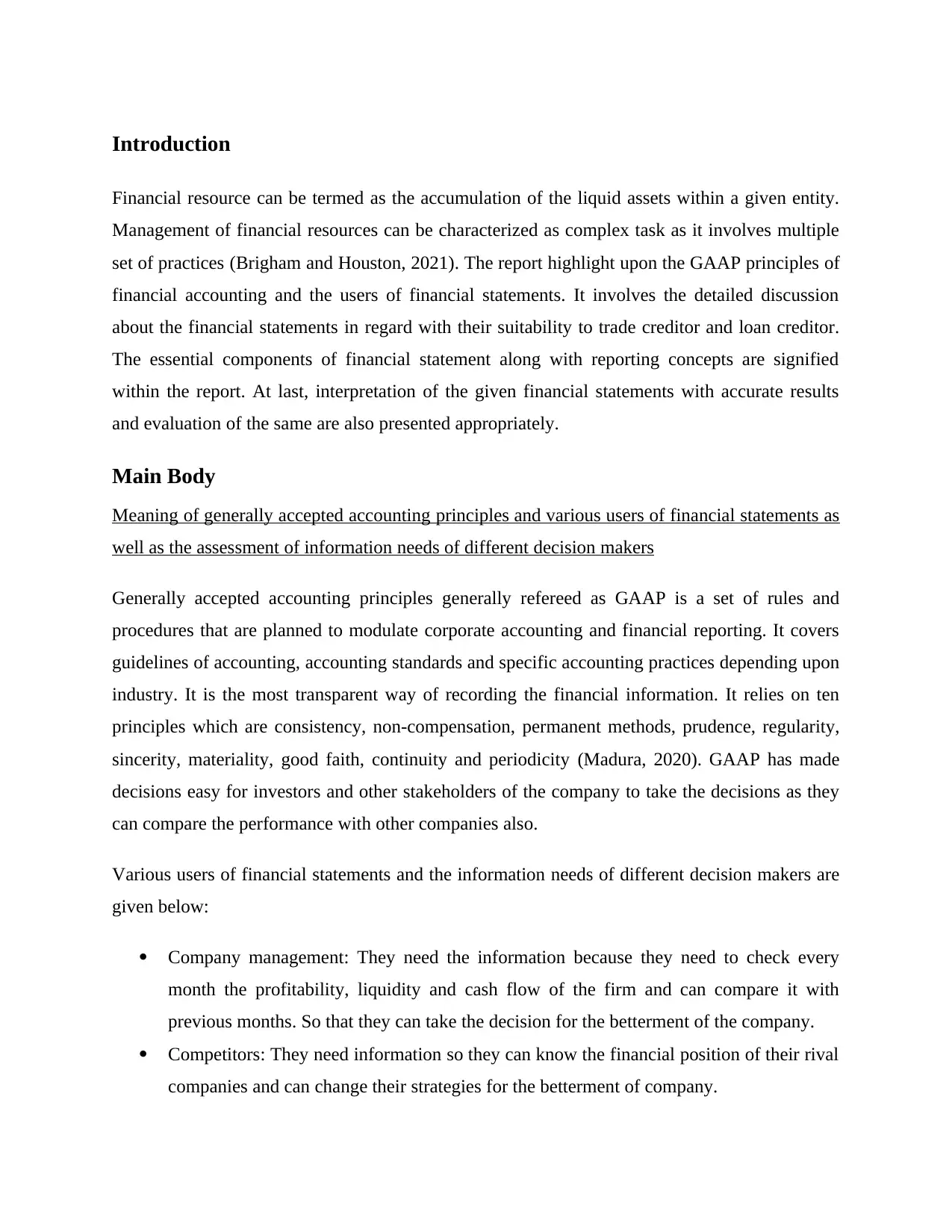
Introduction
Financial resource can be termed as the accumulation of the liquid assets within a given entity.
Management of financial resources can be characterized as complex task as it involves multiple
set of practices (Brigham and Houston, 2021). The report highlight upon the GAAP principles of
financial accounting and the users of financial statements. It involves the detailed discussion
about the financial statements in regard with their suitability to trade creditor and loan creditor.
The essential components of financial statement along with reporting concepts are signified
within the report. At last, interpretation of the given financial statements with accurate results
and evaluation of the same are also presented appropriately.
Main Body
Meaning of generally accepted accounting principles and various users of financial statements as
well as the assessment of information needs of different decision makers
Generally accepted accounting principles generally refereed as GAAP is a set of rules and
procedures that are planned to modulate corporate accounting and financial reporting. It covers
guidelines of accounting, accounting standards and specific accounting practices depending upon
industry. It is the most transparent way of recording the financial information. It relies on ten
principles which are consistency, non-compensation, permanent methods, prudence, regularity,
sincerity, materiality, good faith, continuity and periodicity (Madura, 2020). GAAP has made
decisions easy for investors and other stakeholders of the company to take the decisions as they
can compare the performance with other companies also.
Various users of financial statements and the information needs of different decision makers are
given below:
Company management: They need the information because they need to check every
month the profitability, liquidity and cash flow of the firm and can compare it with
previous months. So that they can take the decision for the betterment of the company.
Competitors: They need information so they can know the financial position of their rival
companies and can change their strategies for the betterment of company.
Financial resource can be termed as the accumulation of the liquid assets within a given entity.
Management of financial resources can be characterized as complex task as it involves multiple
set of practices (Brigham and Houston, 2021). The report highlight upon the GAAP principles of
financial accounting and the users of financial statements. It involves the detailed discussion
about the financial statements in regard with their suitability to trade creditor and loan creditor.
The essential components of financial statement along with reporting concepts are signified
within the report. At last, interpretation of the given financial statements with accurate results
and evaluation of the same are also presented appropriately.
Main Body
Meaning of generally accepted accounting principles and various users of financial statements as
well as the assessment of information needs of different decision makers
Generally accepted accounting principles generally refereed as GAAP is a set of rules and
procedures that are planned to modulate corporate accounting and financial reporting. It covers
guidelines of accounting, accounting standards and specific accounting practices depending upon
industry. It is the most transparent way of recording the financial information. It relies on ten
principles which are consistency, non-compensation, permanent methods, prudence, regularity,
sincerity, materiality, good faith, continuity and periodicity (Madura, 2020). GAAP has made
decisions easy for investors and other stakeholders of the company to take the decisions as they
can compare the performance with other companies also.
Various users of financial statements and the information needs of different decision makers are
given below:
Company management: They need the information because they need to check every
month the profitability, liquidity and cash flow of the firm and can compare it with
previous months. So that they can take the decision for the betterment of the company.
Competitors: They need information so they can know the financial position of their rival
companies and can change their strategies for the betterment of company.
⊘ This is a preview!⊘
Do you want full access?
Subscribe today to unlock all pages.

Trusted by 1+ million students worldwide
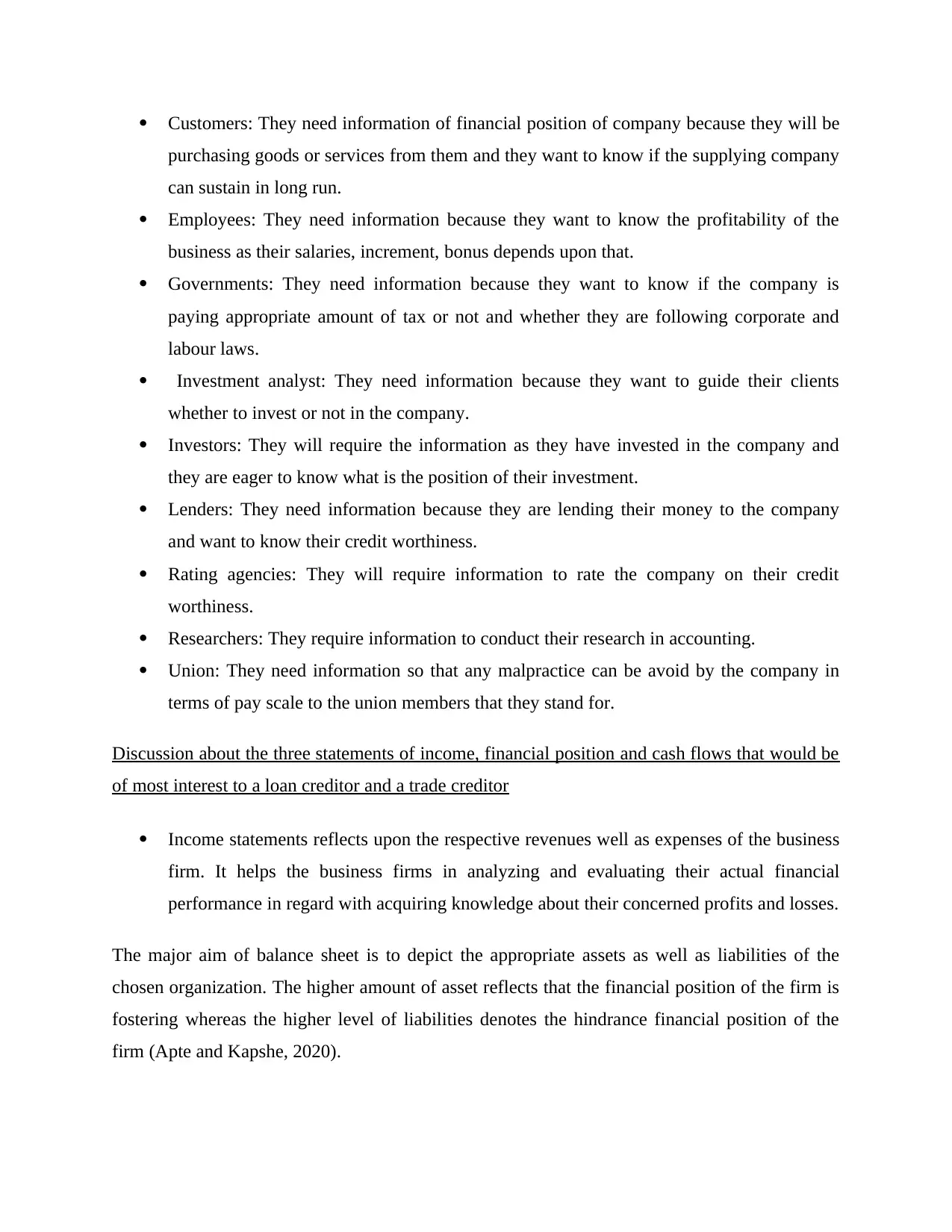
Customers: They need information of financial position of company because they will be
purchasing goods or services from them and they want to know if the supplying company
can sustain in long run.
Employees: They need information because they want to know the profitability of the
business as their salaries, increment, bonus depends upon that.
Governments: They need information because they want to know if the company is
paying appropriate amount of tax or not and whether they are following corporate and
labour laws.
Investment analyst: They need information because they want to guide their clients
whether to invest or not in the company.
Investors: They will require the information as they have invested in the company and
they are eager to know what is the position of their investment.
Lenders: They need information because they are lending their money to the company
and want to know their credit worthiness.
Rating agencies: They will require information to rate the company on their credit
worthiness.
Researchers: They require information to conduct their research in accounting.
Union: They need information so that any malpractice can be avoid by the company in
terms of pay scale to the union members that they stand for.
Discussion about the three statements of income, financial position and cash flows that would be
of most interest to a loan creditor and a trade creditor
Income statements reflects upon the respective revenues well as expenses of the business
firm. It helps the business firms in analyzing and evaluating their actual financial
performance in regard with acquiring knowledge about their concerned profits and losses.
The major aim of balance sheet is to depict the appropriate assets as well as liabilities of the
chosen organization. The higher amount of asset reflects that the financial position of the firm is
fostering whereas the higher level of liabilities denotes the hindrance financial position of the
firm (Apte and Kapshe, 2020).
purchasing goods or services from them and they want to know if the supplying company
can sustain in long run.
Employees: They need information because they want to know the profitability of the
business as their salaries, increment, bonus depends upon that.
Governments: They need information because they want to know if the company is
paying appropriate amount of tax or not and whether they are following corporate and
labour laws.
Investment analyst: They need information because they want to guide their clients
whether to invest or not in the company.
Investors: They will require the information as they have invested in the company and
they are eager to know what is the position of their investment.
Lenders: They need information because they are lending their money to the company
and want to know their credit worthiness.
Rating agencies: They will require information to rate the company on their credit
worthiness.
Researchers: They require information to conduct their research in accounting.
Union: They need information so that any malpractice can be avoid by the company in
terms of pay scale to the union members that they stand for.
Discussion about the three statements of income, financial position and cash flows that would be
of most interest to a loan creditor and a trade creditor
Income statements reflects upon the respective revenues well as expenses of the business
firm. It helps the business firms in analyzing and evaluating their actual financial
performance in regard with acquiring knowledge about their concerned profits and losses.
The major aim of balance sheet is to depict the appropriate assets as well as liabilities of the
chosen organization. The higher amount of asset reflects that the financial position of the firm is
fostering whereas the higher level of liabilities denotes the hindrance financial position of the
firm (Apte and Kapshe, 2020).
Paraphrase This Document
Need a fresh take? Get an instant paraphrase of this document with our AI Paraphraser
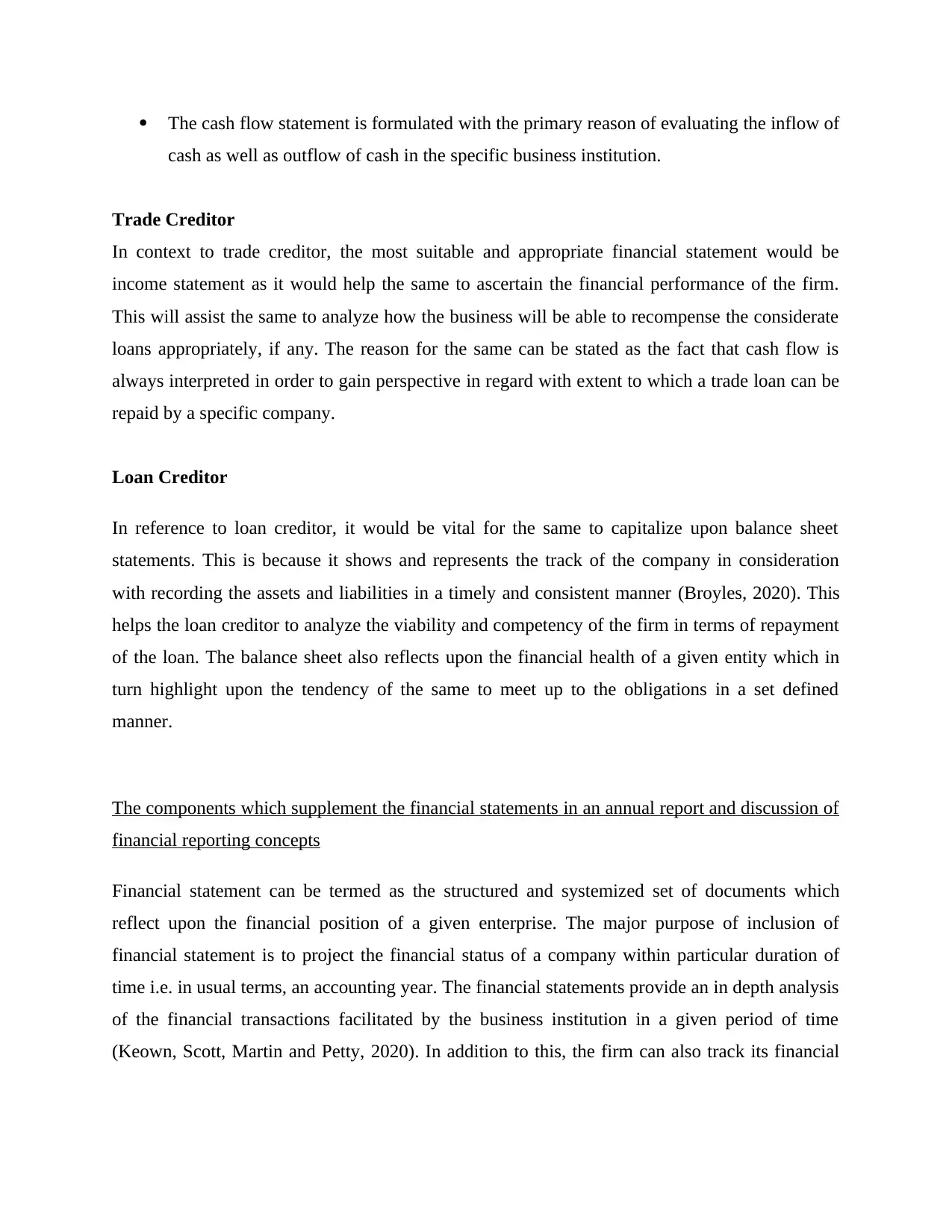
The cash flow statement is formulated with the primary reason of evaluating the inflow of
cash as well as outflow of cash in the specific business institution.
Trade Creditor
In context to trade creditor, the most suitable and appropriate financial statement would be
income statement as it would help the same to ascertain the financial performance of the firm.
This will assist the same to analyze how the business will be able to recompense the considerate
loans appropriately, if any. The reason for the same can be stated as the fact that cash flow is
always interpreted in order to gain perspective in regard with extent to which a trade loan can be
repaid by a specific company.
Loan Creditor
In reference to loan creditor, it would be vital for the same to capitalize upon balance sheet
statements. This is because it shows and represents the track of the company in consideration
with recording the assets and liabilities in a timely and consistent manner (Broyles, 2020). This
helps the loan creditor to analyze the viability and competency of the firm in terms of repayment
of the loan. The balance sheet also reflects upon the financial health of a given entity which in
turn highlight upon the tendency of the same to meet up to the obligations in a set defined
manner.
The components which supplement the financial statements in an annual report and discussion of
financial reporting concepts
Financial statement can be termed as the structured and systemized set of documents which
reflect upon the financial position of a given enterprise. The major purpose of inclusion of
financial statement is to project the financial status of a company within particular duration of
time i.e. in usual terms, an accounting year. The financial statements provide an in depth analysis
of the financial transactions facilitated by the business institution in a given period of time
(Keown, Scott, Martin and Petty, 2020). In addition to this, the firm can also track its financial
cash as well as outflow of cash in the specific business institution.
Trade Creditor
In context to trade creditor, the most suitable and appropriate financial statement would be
income statement as it would help the same to ascertain the financial performance of the firm.
This will assist the same to analyze how the business will be able to recompense the considerate
loans appropriately, if any. The reason for the same can be stated as the fact that cash flow is
always interpreted in order to gain perspective in regard with extent to which a trade loan can be
repaid by a specific company.
Loan Creditor
In reference to loan creditor, it would be vital for the same to capitalize upon balance sheet
statements. This is because it shows and represents the track of the company in consideration
with recording the assets and liabilities in a timely and consistent manner (Broyles, 2020). This
helps the loan creditor to analyze the viability and competency of the firm in terms of repayment
of the loan. The balance sheet also reflects upon the financial health of a given entity which in
turn highlight upon the tendency of the same to meet up to the obligations in a set defined
manner.
The components which supplement the financial statements in an annual report and discussion of
financial reporting concepts
Financial statement can be termed as the structured and systemized set of documents which
reflect upon the financial position of a given enterprise. The major purpose of inclusion of
financial statement is to project the financial status of a company within particular duration of
time i.e. in usual terms, an accounting year. The financial statements provide an in depth analysis
of the financial transactions facilitated by the business institution in a given period of time
(Keown, Scott, Martin and Petty, 2020). In addition to this, the firm can also track its financial
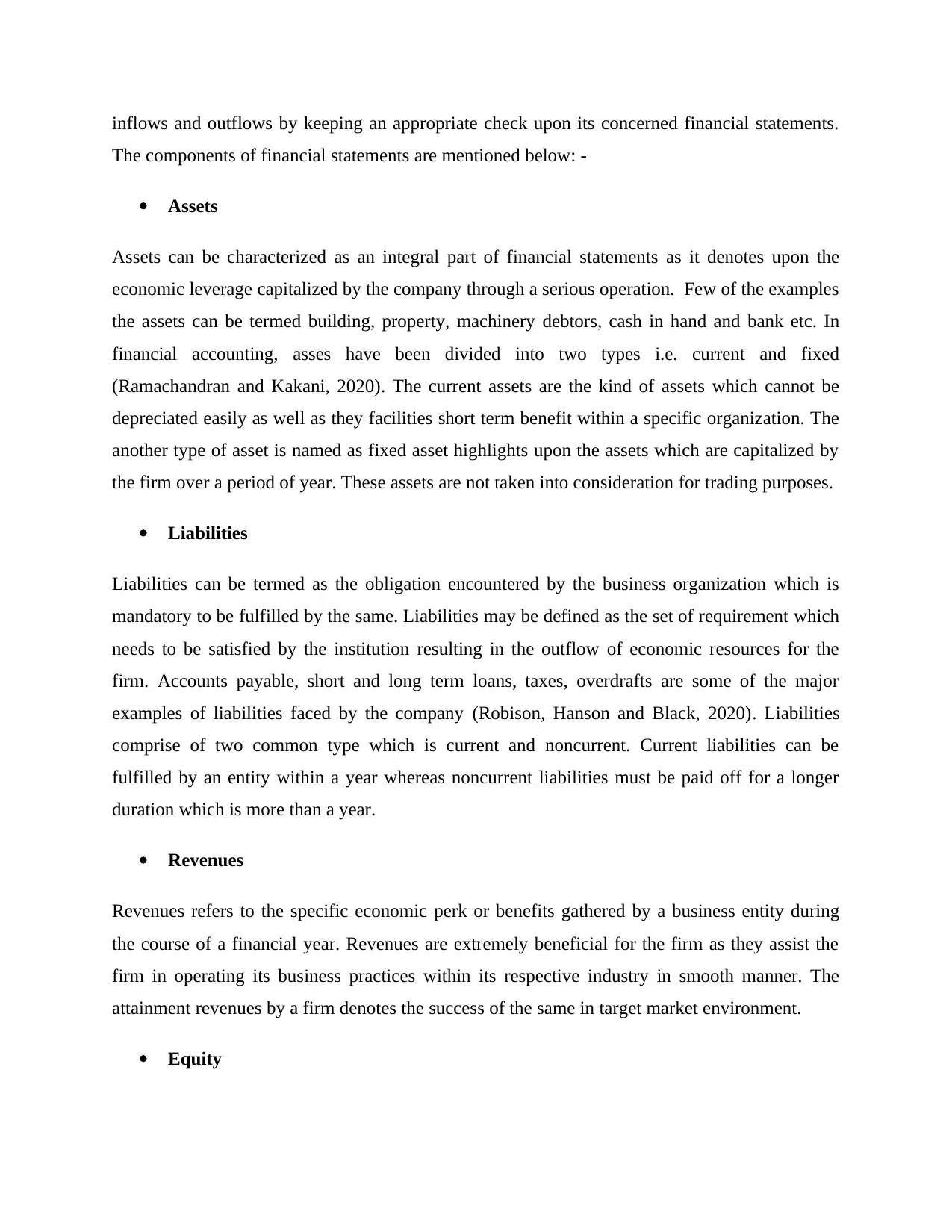
inflows and outflows by keeping an appropriate check upon its concerned financial statements.
The components of financial statements are mentioned below: -
Assets
Assets can be characterized as an integral part of financial statements as it denotes upon the
economic leverage capitalized by the company through a serious operation. Few of the examples
the assets can be termed building, property, machinery debtors, cash in hand and bank etc. In
financial accounting, asses have been divided into two types i.e. current and fixed
(Ramachandran and Kakani, 2020). The current assets are the kind of assets which cannot be
depreciated easily as well as they facilities short term benefit within a specific organization. The
another type of asset is named as fixed asset highlights upon the assets which are capitalized by
the firm over a period of year. These assets are not taken into consideration for trading purposes.
Liabilities
Liabilities can be termed as the obligation encountered by the business organization which is
mandatory to be fulfilled by the same. Liabilities may be defined as the set of requirement which
needs to be satisfied by the institution resulting in the outflow of economic resources for the
firm. Accounts payable, short and long term loans, taxes, overdrafts are some of the major
examples of liabilities faced by the company (Robison, Hanson and Black, 2020). Liabilities
comprise of two common type which is current and noncurrent. Current liabilities can be
fulfilled by an entity within a year whereas noncurrent liabilities must be paid off for a longer
duration which is more than a year.
Revenues
Revenues refers to the specific economic perk or benefits gathered by a business entity during
the course of a financial year. Revenues are extremely beneficial for the firm as they assist the
firm in operating its business practices within its respective industry in smooth manner. The
attainment revenues by a firm denotes the success of the same in target market environment.
Equity
The components of financial statements are mentioned below: -
Assets
Assets can be characterized as an integral part of financial statements as it denotes upon the
economic leverage capitalized by the company through a serious operation. Few of the examples
the assets can be termed building, property, machinery debtors, cash in hand and bank etc. In
financial accounting, asses have been divided into two types i.e. current and fixed
(Ramachandran and Kakani, 2020). The current assets are the kind of assets which cannot be
depreciated easily as well as they facilities short term benefit within a specific organization. The
another type of asset is named as fixed asset highlights upon the assets which are capitalized by
the firm over a period of year. These assets are not taken into consideration for trading purposes.
Liabilities
Liabilities can be termed as the obligation encountered by the business organization which is
mandatory to be fulfilled by the same. Liabilities may be defined as the set of requirement which
needs to be satisfied by the institution resulting in the outflow of economic resources for the
firm. Accounts payable, short and long term loans, taxes, overdrafts are some of the major
examples of liabilities faced by the company (Robison, Hanson and Black, 2020). Liabilities
comprise of two common type which is current and noncurrent. Current liabilities can be
fulfilled by an entity within a year whereas noncurrent liabilities must be paid off for a longer
duration which is more than a year.
Revenues
Revenues refers to the specific economic perk or benefits gathered by a business entity during
the course of a financial year. Revenues are extremely beneficial for the firm as they assist the
firm in operating its business practices within its respective industry in smooth manner. The
attainment revenues by a firm denotes the success of the same in target market environment.
Equity
⊘ This is a preview!⊘
Do you want full access?
Subscribe today to unlock all pages.

Trusted by 1+ million students worldwide
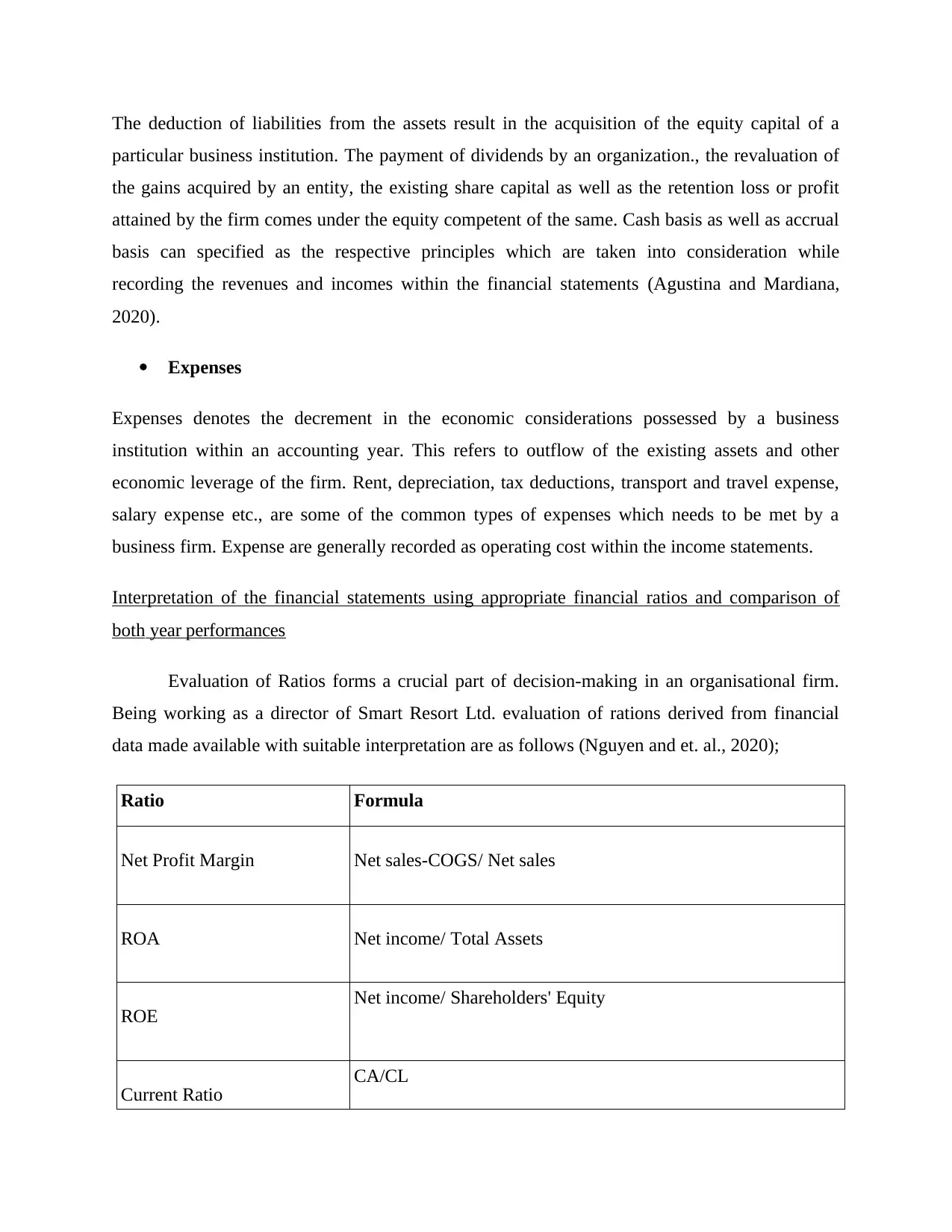
The deduction of liabilities from the assets result in the acquisition of the equity capital of a
particular business institution. The payment of dividends by an organization., the revaluation of
the gains acquired by an entity, the existing share capital as well as the retention loss or profit
attained by the firm comes under the equity competent of the same. Cash basis as well as accrual
basis can specified as the respective principles which are taken into consideration while
recording the revenues and incomes within the financial statements (Agustina and Mardiana,
2020).
Expenses
Expenses denotes the decrement in the economic considerations possessed by a business
institution within an accounting year. This refers to outflow of the existing assets and other
economic leverage of the firm. Rent, depreciation, tax deductions, transport and travel expense,
salary expense etc., are some of the common types of expenses which needs to be met by a
business firm. Expense are generally recorded as operating cost within the income statements.
Interpretation of the financial statements using appropriate financial ratios and comparison of
both year performances
Evaluation of Ratios forms a crucial part of decision-making in an organisational firm.
Being working as a director of Smart Resort Ltd. evaluation of rations derived from financial
data made available with suitable interpretation are as follows (Nguyen and et. al., 2020);
Ratio Formula
Net Profit Margin Net sales-COGS/ Net sales
ROA Net income/ Total Assets
ROE Net income/ Shareholders' Equity
Current Ratio CA/CL
particular business institution. The payment of dividends by an organization., the revaluation of
the gains acquired by an entity, the existing share capital as well as the retention loss or profit
attained by the firm comes under the equity competent of the same. Cash basis as well as accrual
basis can specified as the respective principles which are taken into consideration while
recording the revenues and incomes within the financial statements (Agustina and Mardiana,
2020).
Expenses
Expenses denotes the decrement in the economic considerations possessed by a business
institution within an accounting year. This refers to outflow of the existing assets and other
economic leverage of the firm. Rent, depreciation, tax deductions, transport and travel expense,
salary expense etc., are some of the common types of expenses which needs to be met by a
business firm. Expense are generally recorded as operating cost within the income statements.
Interpretation of the financial statements using appropriate financial ratios and comparison of
both year performances
Evaluation of Ratios forms a crucial part of decision-making in an organisational firm.
Being working as a director of Smart Resort Ltd. evaluation of rations derived from financial
data made available with suitable interpretation are as follows (Nguyen and et. al., 2020);
Ratio Formula
Net Profit Margin Net sales-COGS/ Net sales
ROA Net income/ Total Assets
ROE Net income/ Shareholders' Equity
Current Ratio CA/CL
Paraphrase This Document
Need a fresh take? Get an instant paraphrase of this document with our AI Paraphraser
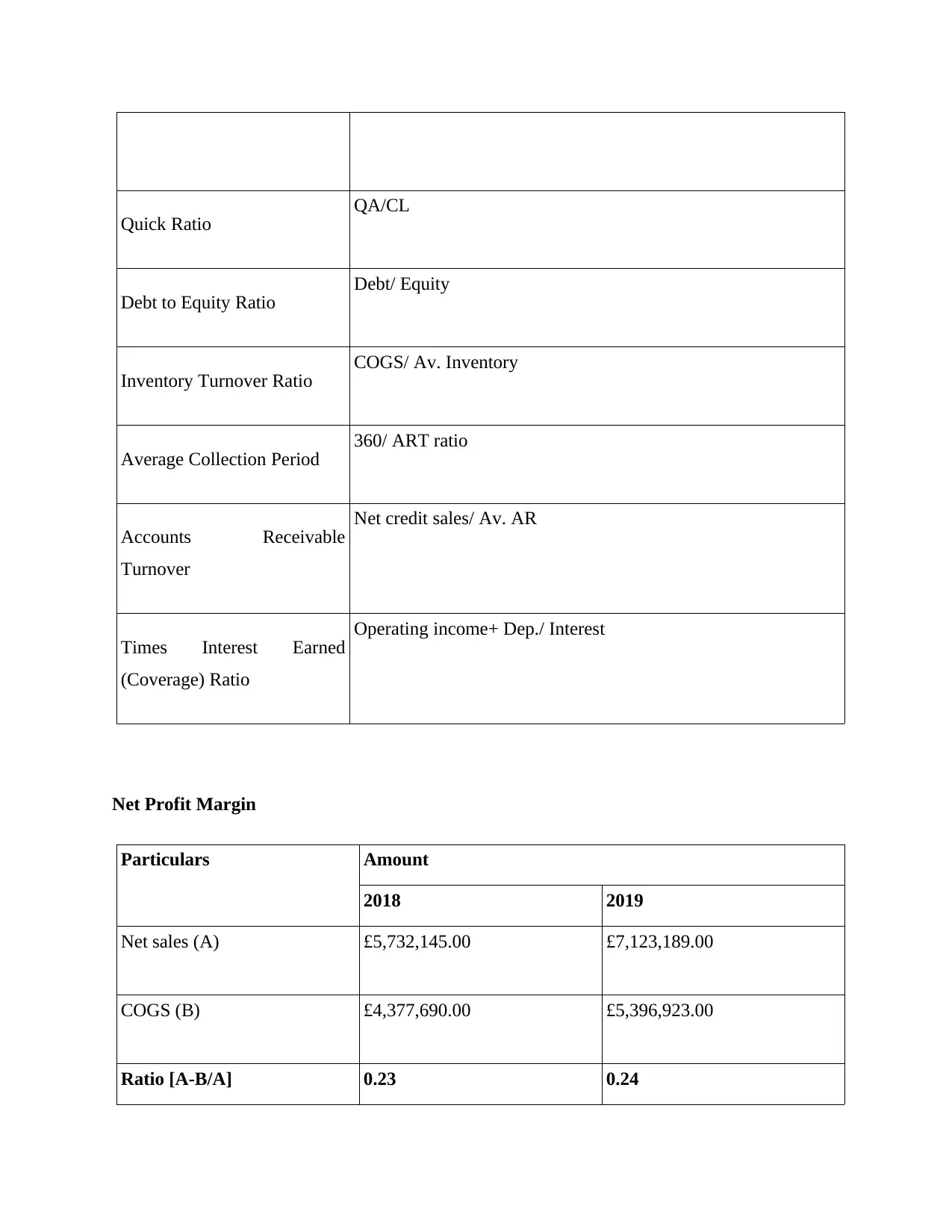
Quick Ratio QA/CL
Debt to Equity Ratio Debt/ Equity
Inventory Turnover Ratio COGS/ Av. Inventory
Average Collection Period 360/ ART ratio
Accounts Receivable
Turnover
Net credit sales/ Av. AR
Times Interest Earned
(Coverage) Ratio
Operating income+ Dep./ Interest
Net Profit Margin
Particulars Amount
2018 2019
Net sales (A) £5,732,145.00 £7,123,189.00
COGS (B) £4,377,690.00 £5,396,923.00
Ratio [A-B/A] 0.23 0.24
Debt to Equity Ratio Debt/ Equity
Inventory Turnover Ratio COGS/ Av. Inventory
Average Collection Period 360/ ART ratio
Accounts Receivable
Turnover
Net credit sales/ Av. AR
Times Interest Earned
(Coverage) Ratio
Operating income+ Dep./ Interest
Net Profit Margin
Particulars Amount
2018 2019
Net sales (A) £5,732,145.00 £7,123,189.00
COGS (B) £4,377,690.00 £5,396,923.00
Ratio [A-B/A] 0.23 0.24
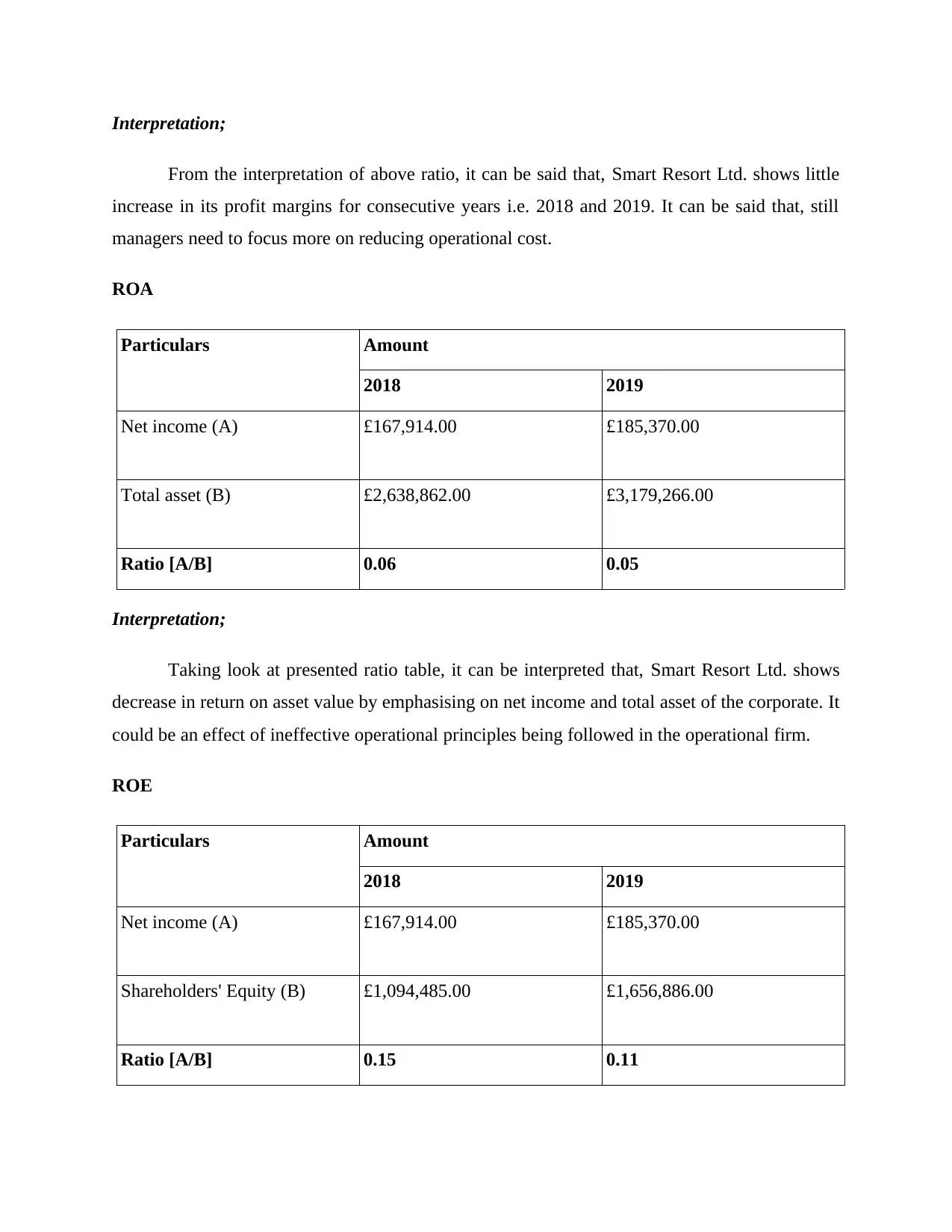
Interpretation;
From the interpretation of above ratio, it can be said that, Smart Resort Ltd. shows little
increase in its profit margins for consecutive years i.e. 2018 and 2019. It can be said that, still
managers need to focus more on reducing operational cost.
ROA
Particulars Amount
2018 2019
Net income (A) £167,914.00 £185,370.00
Total asset (B) £2,638,862.00 £3,179,266.00
Ratio [A/B] 0.06 0.05
Interpretation;
Taking look at presented ratio table, it can be interpreted that, Smart Resort Ltd. shows
decrease in return on asset value by emphasising on net income and total asset of the corporate. It
could be an effect of ineffective operational principles being followed in the operational firm.
ROE
Particulars Amount
2018 2019
Net income (A) £167,914.00 £185,370.00
Shareholders' Equity (B) £1,094,485.00 £1,656,886.00
Ratio [A/B] 0.15 0.11
From the interpretation of above ratio, it can be said that, Smart Resort Ltd. shows little
increase in its profit margins for consecutive years i.e. 2018 and 2019. It can be said that, still
managers need to focus more on reducing operational cost.
ROA
Particulars Amount
2018 2019
Net income (A) £167,914.00 £185,370.00
Total asset (B) £2,638,862.00 £3,179,266.00
Ratio [A/B] 0.06 0.05
Interpretation;
Taking look at presented ratio table, it can be interpreted that, Smart Resort Ltd. shows
decrease in return on asset value by emphasising on net income and total asset of the corporate. It
could be an effect of ineffective operational principles being followed in the operational firm.
ROE
Particulars Amount
2018 2019
Net income (A) £167,914.00 £185,370.00
Shareholders' Equity (B) £1,094,485.00 £1,656,886.00
Ratio [A/B] 0.15 0.11
⊘ This is a preview!⊘
Do you want full access?
Subscribe today to unlock all pages.

Trusted by 1+ million students worldwide
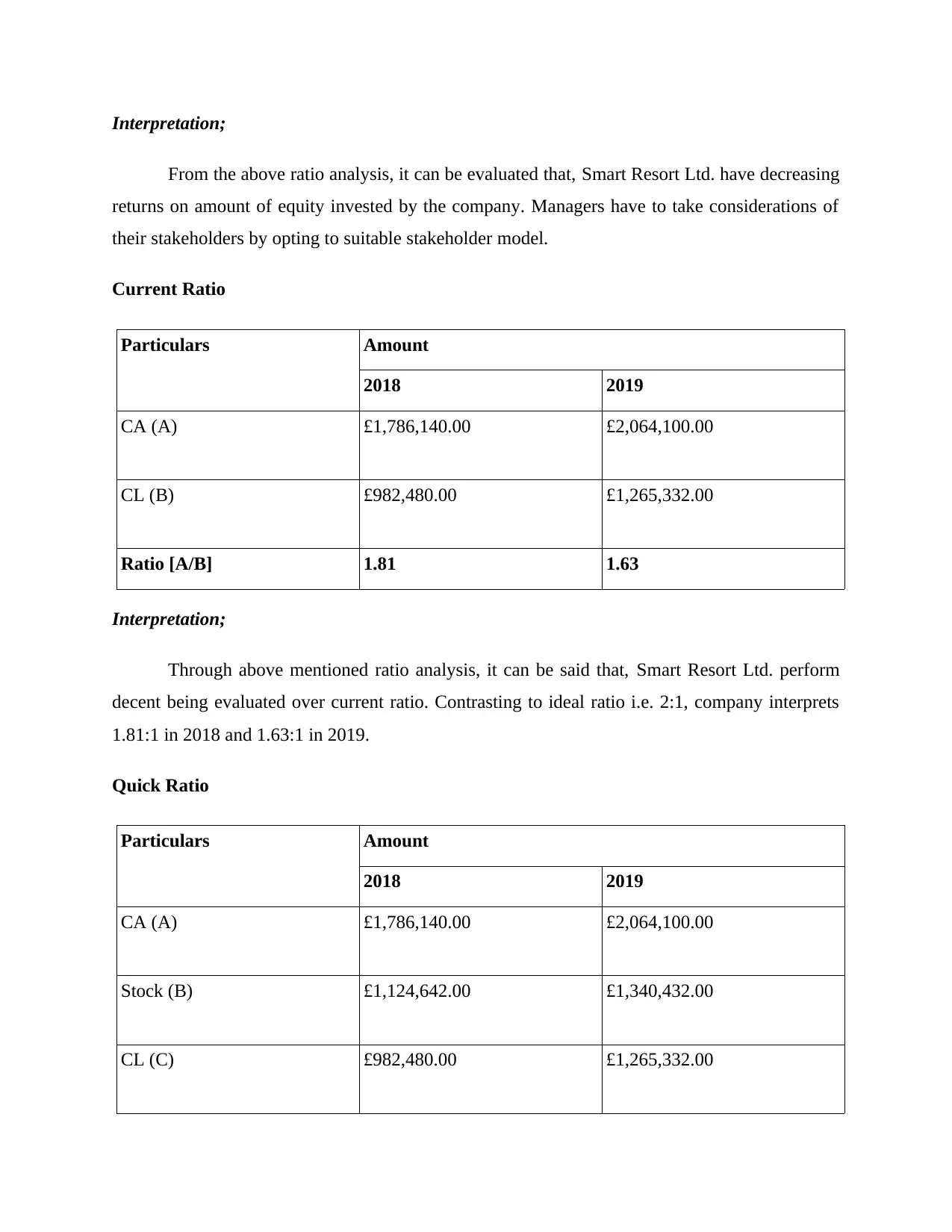
Interpretation;
From the above ratio analysis, it can be evaluated that, Smart Resort Ltd. have decreasing
returns on amount of equity invested by the company. Managers have to take considerations of
their stakeholders by opting to suitable stakeholder model.
Current Ratio
Particulars Amount
2018 2019
CA (A) £1,786,140.00 £2,064,100.00
CL (B) £982,480.00 £1,265,332.00
Ratio [A/B] 1.81 1.63
Interpretation;
Through above mentioned ratio analysis, it can be said that, Smart Resort Ltd. perform
decent being evaluated over current ratio. Contrasting to ideal ratio i.e. 2:1, company interprets
1.81:1 in 2018 and 1.63:1 in 2019.
Quick Ratio
Particulars Amount
2018 2019
CA (A) £1,786,140.00 £2,064,100.00
Stock (B) £1,124,642.00 £1,340,432.00
CL (C) £982,480.00 £1,265,332.00
From the above ratio analysis, it can be evaluated that, Smart Resort Ltd. have decreasing
returns on amount of equity invested by the company. Managers have to take considerations of
their stakeholders by opting to suitable stakeholder model.
Current Ratio
Particulars Amount
2018 2019
CA (A) £1,786,140.00 £2,064,100.00
CL (B) £982,480.00 £1,265,332.00
Ratio [A/B] 1.81 1.63
Interpretation;
Through above mentioned ratio analysis, it can be said that, Smart Resort Ltd. perform
decent being evaluated over current ratio. Contrasting to ideal ratio i.e. 2:1, company interprets
1.81:1 in 2018 and 1.63:1 in 2019.
Quick Ratio
Particulars Amount
2018 2019
CA (A) £1,786,140.00 £2,064,100.00
Stock (B) £1,124,642.00 £1,340,432.00
CL (C) £982,480.00 £1,265,332.00
Paraphrase This Document
Need a fresh take? Get an instant paraphrase of this document with our AI Paraphraser
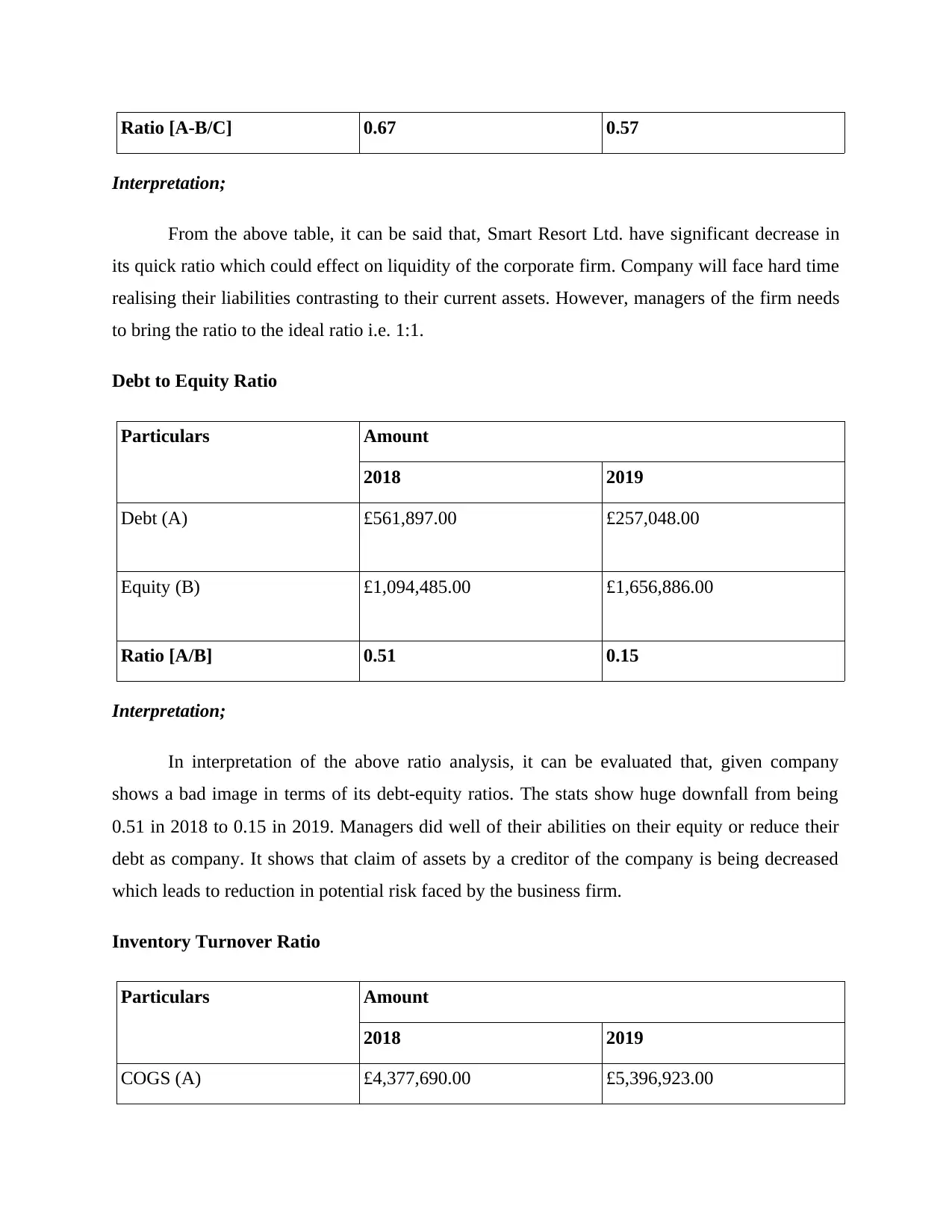
Ratio [A-B/C] 0.67 0.57
Interpretation;
From the above table, it can be said that, Smart Resort Ltd. have significant decrease in
its quick ratio which could effect on liquidity of the corporate firm. Company will face hard time
realising their liabilities contrasting to their current assets. However, managers of the firm needs
to bring the ratio to the ideal ratio i.e. 1:1.
Debt to Equity Ratio
Particulars Amount
2018 2019
Debt (A) £561,897.00 £257,048.00
Equity (B) £1,094,485.00 £1,656,886.00
Ratio [A/B] 0.51 0.15
Interpretation;
In interpretation of the above ratio analysis, it can be evaluated that, given company
shows a bad image in terms of its debt-equity ratios. The stats show huge downfall from being
0.51 in 2018 to 0.15 in 2019. Managers did well of their abilities on their equity or reduce their
debt as company. It shows that claim of assets by a creditor of the company is being decreased
which leads to reduction in potential risk faced by the business firm.
Inventory Turnover Ratio
Particulars Amount
2018 2019
COGS (A) £4,377,690.00 £5,396,923.00
Interpretation;
From the above table, it can be said that, Smart Resort Ltd. have significant decrease in
its quick ratio which could effect on liquidity of the corporate firm. Company will face hard time
realising their liabilities contrasting to their current assets. However, managers of the firm needs
to bring the ratio to the ideal ratio i.e. 1:1.
Debt to Equity Ratio
Particulars Amount
2018 2019
Debt (A) £561,897.00 £257,048.00
Equity (B) £1,094,485.00 £1,656,886.00
Ratio [A/B] 0.51 0.15
Interpretation;
In interpretation of the above ratio analysis, it can be evaluated that, given company
shows a bad image in terms of its debt-equity ratios. The stats show huge downfall from being
0.51 in 2018 to 0.15 in 2019. Managers did well of their abilities on their equity or reduce their
debt as company. It shows that claim of assets by a creditor of the company is being decreased
which leads to reduction in potential risk faced by the business firm.
Inventory Turnover Ratio
Particulars Amount
2018 2019
COGS (A) £4,377,690.00 £5,396,923.00
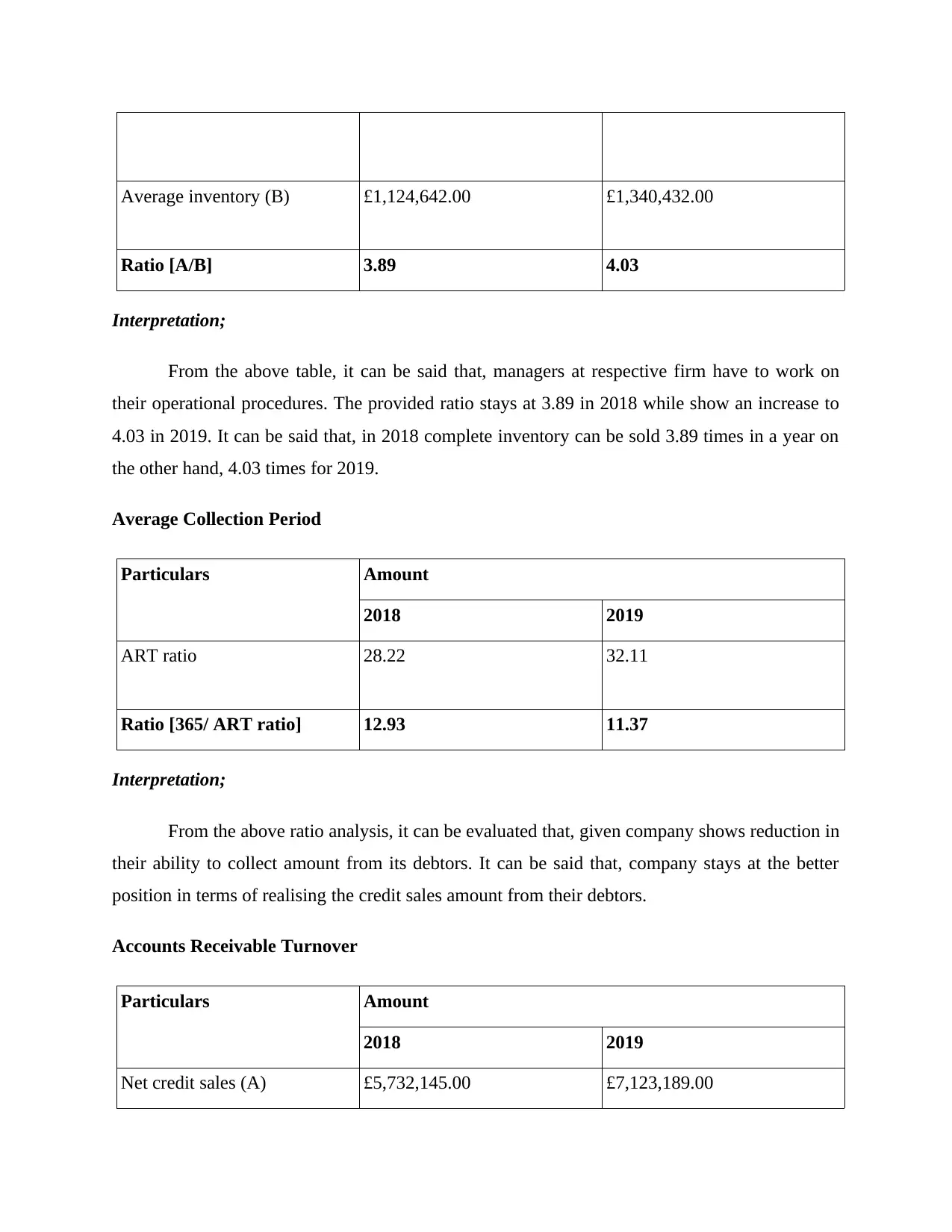
Average inventory (B) £1,124,642.00 £1,340,432.00
Ratio [A/B] 3.89 4.03
Interpretation;
From the above table, it can be said that, managers at respective firm have to work on
their operational procedures. The provided ratio stays at 3.89 in 2018 while show an increase to
4.03 in 2019. It can be said that, in 2018 complete inventory can be sold 3.89 times in a year on
the other hand, 4.03 times for 2019.
Average Collection Period
Particulars Amount
2018 2019
ART ratio 28.22 32.11
Ratio [365/ ART ratio] 12.93 11.37
Interpretation;
From the above ratio analysis, it can be evaluated that, given company shows reduction in
their ability to collect amount from its debtors. It can be said that, company stays at the better
position in terms of realising the credit sales amount from their debtors.
Accounts Receivable Turnover
Particulars Amount
2018 2019
Net credit sales (A) £5,732,145.00 £7,123,189.00
Ratio [A/B] 3.89 4.03
Interpretation;
From the above table, it can be said that, managers at respective firm have to work on
their operational procedures. The provided ratio stays at 3.89 in 2018 while show an increase to
4.03 in 2019. It can be said that, in 2018 complete inventory can be sold 3.89 times in a year on
the other hand, 4.03 times for 2019.
Average Collection Period
Particulars Amount
2018 2019
ART ratio 28.22 32.11
Ratio [365/ ART ratio] 12.93 11.37
Interpretation;
From the above ratio analysis, it can be evaluated that, given company shows reduction in
their ability to collect amount from its debtors. It can be said that, company stays at the better
position in terms of realising the credit sales amount from their debtors.
Accounts Receivable Turnover
Particulars Amount
2018 2019
Net credit sales (A) £5,732,145.00 £7,123,189.00
⊘ This is a preview!⊘
Do you want full access?
Subscribe today to unlock all pages.

Trusted by 1+ million students worldwide
1 out of 15
Related Documents
Your All-in-One AI-Powered Toolkit for Academic Success.
+13062052269
info@desklib.com
Available 24*7 on WhatsApp / Email
![[object Object]](/_next/static/media/star-bottom.7253800d.svg)
Unlock your academic potential
Copyright © 2020–2025 A2Z Services. All Rights Reserved. Developed and managed by ZUCOL.

